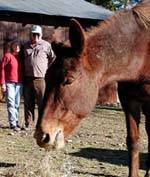Black Ruby is a world champion. Living on a quiet ranch just off
Chalk Hill Road between Alexander Valley and Windsor, she is the
holder of three world records.
Last July, Sports Illustrated and the New York Times ran stories
about Black Ruby. In 2003, a new book, “Chicken Soup for the Horse
Lover’s Soul,” will include a story about her. She is the world’s
pre-eminent racing mule.
Black Ruby’s owners, Sonny and Mary McPherson, used to raise
sheep on their ranch, but in the past few years, their lives have
been taken over by mules.
“Doc Campbell got me started,” said Sonny, referring to Dr.
Charles Campbell, a Healdsburg veterinarian for 50 years.
In the early 1990s tax laws changed, Campbell explained during a
recent conversation. Thoroughbred race horses could no longer be
claimed as livestock for tax purposes. As a result, the number of
thoroughbreds showing up on the racing circuit dropped.
“They weren’t filling the cards for races,” said Campbell, “and
the county fairs are supported by horse racing.” Something had to
be done.
As thoroughbred numbers declined, four other breeds — arabians,
appaloosas, quarter horses and mules — began filling the racing
cards. Mules are the most recent “emerging breed” at the tracks,
but already, according to Sonny, they are making more money than
the others.
“To see a bunch of mules running like hell is a real crowd
pleaser,” said Campbell. “Some tracks are now running two and three
mule races a day.”
In 1993, the McPhersons had picked up some riding mules, and one
of them caught Campbell’s attention when he visited the McPherson
ranch.
“Bring it to the track. Let’s see if it’ll run,” Sonny remembers
Campbell saying. It turned out the mule, whose name was Stardust,
was indeed a runner.
Pari-mutuel mule racing had not yet been legalized in
California, but Stardust won some races in Nevada. Then, because of
a freak accident, she had to be put down.
In 1995, pari-mutuel betting on mule racing was legalized for
the fair circuit in California. Hearing of a promising-looking mule
in Attalla, Alabama, Sonny went to have a look and found a
completely wild animal that turned out to be extremely hard to
catch. Impressed with her speed, McPherson brought the mule home,
and named her Fancy.
There were only 28 days before the racing season was to open in
Winnemucca, Nevada. That didn’t allow much time for training, but
Fancy won her first race anyway.
By the end of that racing season, Fancy had been declared the
3-year-old futurity champion of the mule-racing world.
The following year, a chestnut mule with flaxen mane and a dark
spot on her rump, beat Fancy at a race in Bishop, California. When
the chestnut mule did it again the following week in Winnemucca,
Sonny decided he’d had enough of that, so he bought out the
competition, and became Black Ruby’s new owner.
Black Ruby was only partially broken, and resisted going into
the starting gate. “They said we could never train her,” said
McPherson. But trainer, Jerry Jackson, didn’t believe it. “You’ve
got a winner here,” said Jackson. “We are going to break her.”
Black Ruby, the offspring of a quarter horse mother and a
jackass father, won her first race for the new owners at the
Humboldt County Fair in June, 1996. She has rarely lost since,
amassing total winnings of $201,980 — $51,120 of which came in
2002.
Black Ruby consistently wins races at distances of 250 to 870
yards — the full span of mule-racing events — and holds the world
record times for 350, 440, and 660 yards. Campbell calls her, “The
Sea Biscuit of the mule world.”
Taz, from Post Falls, Idaho, is the only mule that has ever
seriously challenged Black Ruby. The two mules have faced each
other 38 times, with Black Ruby winning 26 of those races.
Male mules are usually stronger than females, Sonny said, “but
Ruby is just a freak.”
“She just loves to run,” added Mary.
Since its inception in 1995, the popularity of pari-mutuel mule
racing has steadily increased. In 1995 a purse for a mule race was
usually around $2,000 — 55 percent going to the winner, and the
rest being divvied up among the also rans.
The size of purses depends on how much betting has taken place
in the previous year. With betting on mule races increasing each
year, the purses have grown steadily, until now a $10,000 purse is
not uncommon.
Black Ruby’s dominance poses a problem for race organizers. Many
now allow only “win betting” on Black Ruby. “Place betting” and
“show betting” — wagering that she’ll finish no lower than second
or third — is disallowed, because Black Ruby simply never finishes
lower than that.
Last summer the prestigious Del Mar Racetrack near San Diego
invited Black Ruby and Taz to run an exhibition match race
following the day’s regular racing card. No animal other than a
thoroughbred had ever been on the Del Mar track.
“When they invited us down we thought it was a joke at first,”
said Mary, but it wasn’t.
Two weeks before the Del Mar race, Black Ruby and Taz faced off
at Cal Expo. In an attempt to even out the competition, race
organizers had required that Black Ruby carry 136 pounds while Taz
carried only 128.
Taz won that race. It was Black Ruby’s first loss in two years,
and the outcome drew increased attention to the Del Mar event.
On September 8, with both mules carrying 129 pounds in a 400
yard race, Black Ruby beat Taz at Del Mar by two lengths.
A week later, on September 14, the two mules met again for a 350
yard race at Fairplex Park in Pomona. With Black Ruby spotting Taz
five pounds, she beat him again by half a length.
Last September the Pimlico Racetrack, site of the Triple Crown
Preakness Stakes, invited Black Ruby to make an appearance on that
East Coast track. No race was planned. Organizers were willing to
pay a healthy appearance fee simply to give their patrons a look at
the famous racing mule. Because of West Coast races the McPherson’s
did not take Black Ruby to Baltimore, but Mary said that rumors
continue of possible East Coast engagements in the future.
Black Ruby is currently enjoying a leisurely off-season on the
McPherson ranch, along with Fancy, who still runs, the
up-and-coming Little John, and several other racing mules.
According to McPherson, a top thoroughbred will garner no more
than 15 to 20 wins, and then will be put out to stud. But mules —
incapable of reproducing — just keep on running. Black Ruby’s
record now stands at 62 wins, nine seconds, and three thirds.
The Mule Racing Association has determined that mules must be
put out to pasture at age 16, though they often live twice that
long. Sonny McPherson said that, barring injury, there is no reason
to think that Black Ruby won’t just keep running, and winning,
until the day she retires.









